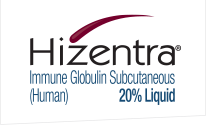
HCP Resources to Assist in SCIg Therapy Management
CSL Behring provides helpful resources to help you support your patients' use of Hizentra and address infusion problems if they occur.
Managing Common Infusion Issues
Your patients may experience issues during or after infusion with SCIg therapy. Use these clinical management troubleshooting techniques to possibly help resolve issues that may arise.13
Local Reaction
- Assess for tape allergy—change to paper/hypoallergenic tape
- Assess needle gauge—choose a needle that is consistent with volume being infused
- Assess length of needle—may be too short and infusion may be intradermal
- Assess site location—may not be penetrating subcutaneous tissue
- Choose sites with appropriate amount of subcutaneous tissue
- Avoid tracking IgG through intradermal tissue by not allowing drops of IgG on needle tip prior to needle insertion (prime dry)
- Assess appropriateness of rotating sites based on previous tolerability
- Consider use of topical anesthetic ointment
- Avoid infusion into areas where the skin is tender, bruised, red, or hard. Avoid infusing into scars or stretch marks
Leaking at Infusion Site
- Assess needle and catheter—ensure they are affixed securely and fully inserted
- Assess placement—may be in location that is subject to movement; advise regarding selection of site
- Assess length of subcutaneous needle—may be too short; suggest change
- Assess rate of infusion volume—amount per site may be too great; adjust volume
- Assess rate of infusion—adjust rate (rate may be too fast)
Discomfort With Needle
- Assess needle length—may be too long and irritating to the infusion site
- Consider applying cold pack or topical anesthetic cream prior to insertion
Infusion Issues
- Assess product storage—Hizentra is ready to use at room temperature; no refrigeration required
- Assess volume per site, rate of infusion, and number of sites, or adjust infusion regimen
- Check manufacturer's instructions for pump setting, correct selection of tubing size and length to match infusion rates; check pump function, battery function, etc
- Arrange observation of patient technique (specialty pharmacy provider or office visit)
Additional Resources for HCPs to Help Patients Manage Therapy
CSL Behring is committed to helping you help your patients effectively self-administer Hizentra. Explore these links for more information.

Good initial self-infusion training can help patients avoid problems going forward.
So, whether it’s our welcome kit for patients new to Hizentra, or our Hizentra app that reminds all patients of scheduled infusions and allows them to enter treatment details from the palm of their hand, we offer a variety of resources to help patients become adept with their therapy.

Optimize patient care with nurse education and training on SCIg administration through the SHARE Nurse Training Center.
Hizentra Support Programs
Hizentra ConnectSM is a comprehensive resource center to help you and your patients. Through Hizentra Connect, patients can receive in-home nurse training and infusion equipment at no cost. For qualified patients, the Free Trial program provides a month's supply of product.

More information about helping patients get started on Hizentra may be found in our FAQ section.
